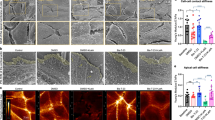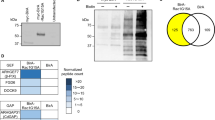Abstract
Cadmium is a toxic metal that produces oxidative stress and has been shown to disrupt the actin cytoskeleton in rat renal mesangial cells (RMC). In a survey of proteins that might undergo Cd2+-dependent disulfide crosslinking, we identified the adenylyl cyclase-associated protein, CAP1, as undergoing a dimerization in response to Cd2+ (5–40 µM) that was sensitive to disulfide reducing agents, was reproduced by the disulfide crosslinking agent diamide, and was shown by site-directed mutagenesis to involve the Cys29 residue of the protein. Reactive oxygen species are not involved in the thiol oxidation, and glutathione modulates background levels of dimer. CAP1 is known to enhance cofilin’s F-actin severing activity through binding to F-actin and cofilin. F-actin sedimentation and GST-cofilin pulldown studies of CAP1 demonstrated enrichment of the CAP1 dimer’s association with cofilin, and in the cofilin–F-actin pellet, suggesting that Cd2+-induced dimer increases the formation of a CAP1–cofilin–F-actin complex. Both siRNA-based silencing of CAP1 and overexpression of a CAP1 mutant lacking Cys29 (and therefore, incapable of dimerization in response to Cd2+) increased RMC viability and provided some protection of F-actin structures against Cd2+. It is concluded that Cd2+ brings about disruption of the RMC cytoskeleton in part through formation of a CAP1 dimer that increases recruitment of cofilin to F-actin filaments.












Similar content being viewed by others
References
Apostolova MD, Christova T, Templeton DM (2006) Involvement of gelsolin in cadmium-induced disruption of the mesangial cell cytoskeleton. Toxicol Sci 89:465–474
Beyersmann D, Hechtenberg S (1997) Cadmium, gene regulation, and cellular signalling in mammalian cells. Toxicol Appl Pharmacol 144:247–261
Brennan JP, Wait R, Begum S, Bell JR, Dunn MJ, Eaton P (2004) Detection and mapping of widespread intermolecular protein disulfide formation during cardiac oxidative stress using proteomics with diagonal electrophoresis. J Biol Chem 279:41352–41360
Chaudhry F, Breitsprecher D, Little K, Sharov G, Sokolova O, Goode BL (2013) Srv2/cyclase-associated protein forms hexameric shurikens that directly catalyze actin filament severing by cofilin. Mol Biol Cell 24(1):31–41
Chin TA, Templeton DM (1993) Protective elevations of glutathione and metallothionein in cadmium-exposed mesangial cells. Toxicology 77:145–156
Choong G, Liu Y, Templeton DM (2013a) Cadmium affects focal adhesion kinase (FAK) in mesangial cells: Involvement of CaMK-II and the actin cytoskeleton. J Cell Biochem 114:1832–1842
Choong G, Liu Y, Xiao W, Templeton DM (2013b) Cadmium-induced glutathionylation of actin occurs through a ROS-independent mechanism: implications for cytoskeletal integrity. Toxicol Appl Pharmacol 272:423–430
Choong G, Liu Y, Templeton DM (2014) Interplay of cadmium and calcium in mediating cadmium toxicity. Chem Biol Interact 211:54–65
Dalle-Donne I, Giustarini D, Rossi R, Colombo R, Milzani A (2003) Reversible S-glutathionylation of Cys374 regulates actin filament formation by inducing structural changes in the actin molecule. Free Radic Biol Med 34:23–32
Field J, Vojtek A, Ballester R et al (1990) Cloning and characterization of CAP, the S. cerevisiae gene encoding the 70 kd adenylyl cyclase-associated protein. Cell 61:319–327
Freeman NL, Field J (2000) Mammalian homolog of the yeast adenylyl cyclase associated protein, CAP/Srv2p, regulates actin filament assembly. Cell Motil Cytoskelet 45:106–120
Freisinger E, Vašák M (2012) Cadmium in metallothioneins. Met Ions Life Sci 11:339–371
Funk AE, Day FA, Brady FO (1987) Displacement of zinc and copper from copper-induced metallothionein by cadmium and by mercury: in vivo and ex vivo studies. Comp Biochem Physiol C 86:1–6
Furukawa R, Maselli A, Thomson SAM, Lim RWL, Stokes JV, Fechheimer M (2003) Calcium regulation of actin crosslinking is important for function of the actin cytoskeleton in Dictyostelium. J Cell Sci 116:187–196
Gerst JE, Ferguson K, Vojtek A, Wigler M, Field J (1991) CAP is a bifunctional component of the Saccharomyces cerevisiae adenylyl cyclase complex. Mol Cell Biol 11:1248–1257
Hartwig A (1994) Role of DNA repair inhibition in lead- and cadmium-induced genotoxicity: a review. Environ Health Perspect 102(Suppl.3):45–50
Hubberstey AV, Mottillo EP (2002) Cyclase-associated proteins: CAPacity for linking signal transduction and actin polymerization. FASEB J 16:487–499
Jansen S, Collins A, Golden L, Sokolova O, Goode BL (2014) Structure and mechanism of mouse cyclase-associated protein (CAP1) in regulating actin dynamics. J Biol Chem 289:30732–39742
Lee SH, Dominguez R (2010) Regulation of actin cytoskeleton dynamics in cells. Mol Cells 29:311–325
Liu Y, Templeton DM (2007) Cadmium activates CaMK-II and initiates CaMK-II-dependent apoptosis in mesangial cells. FEBS Lett 581:1481–1486
Liu Y, Templeton DM (2008) Initiation of caspase-independent death in mouse mesangial cells by Cd2+: involvement of p38 kinase and CaMK-II. J Cell Physiol 217:307–318
Liu Y, Templeton DM (2010) Role of the cytoskeleton in Cd2+-induced death of mouse mesangial cells. Can J Physiol Pharmacol 88:341–352
Liu Y, Templeton DM (2013) Involvement of CaMK-IIδ and gelsolin in Cd2+-dependent cytoskeletal effects in mesangial cells. J Cell Physiol 228:78–86
Liu Y, Templeton DM (2015) Iron-dependent turnover of IRP-1/c-aconitase in kidney cells. Metallomics 7:766–775
Liu J, Qu W, Kadiiska MB (2009) Role of oxidative stress in cadmium toxicity and carcinogenesis. Toxicol Appl Pharmacol 238:209–214
Liu Y, Xiao W, Templeton DM (2014) Cadmium-induced aggregation of iron regulatory protein-1. Toxicology 324:108–115
López E, Arce C, Oset-Gasque MJ, Canadas S, González MP (2006) Cadmium iinduces reactive oxygen species generation and lipid peroxidation in cortical neurons in culture. Free Radic Biol Med 40:940–951
Lu S, Fan S-B, Yang B et al (2015) Mapping native disulfide bonds at a proteome scale. Nat Methods 12:329–331
Moriyama K, Yahara I (2002) Human CAP1 is a key factor in the recycling of cofilin and actin for rapid actin turnover. J Cell Sci 115:1591–1601
Nordberg GF (2009) Historical perspectives on cadmium toxicology. Toxicol Appl Pharmacol 238:192–200
Normoyle KPM, Brieher WM (2012) Cyclase-associated protein (CAP) acts directly on F-actin to accelerate cofilin-mediated actin severing across the range of physiological pH. J Biol Chem 287(42):35722–35732
Oh S-H, Lim S-C (2006) A rapid and transient ROS generation by cadmium triggers apoptosis via caspase-dependent pathway in HepG2 cells and this is inhibited through N-acetylcysteine-mediated catalase upregulation. Toxicol Appl Pharmacol 212:212–223
Olson EN, Nordheim A (2010) Linking actin dynamics and gene transcription to drive cellular motile functions. Nat Rev Mol Cell Biol 11:353–365
Ono S (2013) The role of cyclase-associated protein in regulating actin filament dynamics—more than a monomer-sequestration factor. J Cell Sci 126(Pt 15):3249–3258
Peche V, Shekar S, Leichter M et al (2007) CAP2, cyclase-associated protein 2, is a dual compartment protein. Cell Mol Life Sci 64:2702–2715
Pope B, Maciver S, Weeds A (1995) Localization of the calcium-sensitive actin monomer binding site in gelsolin to segment 4 and identification of calcium binding sites. Biochemistry 34:1583–1588
Quintero-Monzon O, Jonasson EM, Bertling E et al (2009) Reconstitution and dissection of the 600-kDa Srv2/CAP complex: roles for oligomerization and cofilin-actin binding in driving actin turnover. J Biol Chem 284:10923–10934
Shima F, Okada T, Kido M et al (2000) Association of yeast adenylyl cyclase with cyclase-associated protein CAP forms a second Ras-binding site which mediates its Ras-dependent activation. Mol Cell Biol 20:26–33
Templeton DM, Liu Y (2010) Multiple roles of cadmium in cell death and survival. Chemico-Biol Interact 188:267–275
Thévenod F (2009) Cadmium and cellular signaling cascades: to be or not to be? Toxicol Appl Pharmacol 238:221–239
Thévenod F, Lee W-K (2013) Toxicology of cadmium and its damage to mammalian organs. In: Sigel A, Sigel H, Sigel RK (eds) Cadmium: from toxicity to essentiality. Springer, Dordrecht, pp 415–490
Thévenod F, Lee W-K (2015) Live and let die: roles of autophagy in cadmium nephrotoxicity. Toxics 3:130–151
Vandekerchove J (1993) Actins. In: Kreis T, Vale R (eds) Guidebook to the Cytoskeletal and Motor Proteins. Oxford University Press, Oxford, pp 13–15
Wang Z, Templeton DM (1996) Cellular factors mediate cadmium-dependent actin depolymerization. Toxicol Appl Pharmacol 139:115–121
Wang Z, Templeton DM (1998) Induction of c-fos proto-oncogene in mesangial cells by cadmium. J Biol Chem 273:73–79
Wang Z, Chin TA, Templeton DM (1996) Calcium-independent effects of cadmium on actin assembly in mesangial and vascular smooth muscle cells. Cell Motil Cytoskelet 32:208–222
Wang Y, Yang J, Yi J (2012) Redox sensing by proteins: oxidative modifications on cysteines and the consequent events. Antiox Redox Signal 16(7):649–657
Xiao W, Liu Y, Templeton DM (2009) Pleiotropic effects of cadmium in mesangial cells. Toxicol Appl Pharmacol 238:315–326
Yu J, Wang C, Palmieri SJ, Haarer BK, Field J (1999) A cytoskeletal localizing domain in the cyclase-associated protein, CAP/Srv2p, regulates access to a distant SH3-binding site. J Biol Chem 274:19985–19981
Zhang H, Ghai P, Wu H, Wang C, Field J, Zhou G-L (2013) Mammalian adenylyl cyclase-associated protein 1 (CAP1) regulates cofilin function, the actin cytoskeleton, and cell adhesion. [Erratum appears in J Biol Chem 288:28306 (2013)]. J Biol Chem 288:20966–20977
Zhou G-L, Zhang H, Wu H, Ghai P, Field J (2014) Phosphorylation of the cytoskeletal protein CAP1 controls its association with cofilin and actin. J Cell Sci 127(23):5052–5065
Acknowledgements
This work was funded by Grant #418208 to DMT from the Natural Sciences and Engineering Research Council of Canada.
Author information
Authors and Affiliations
Corresponding author
Ethics declarations
Conflict of interest
The authors declare that they have no conflict of interest.
Electronic supplementary material
Below is the link to the electronic supplementary material.
204_2017_2142_MOESM1_ESM.tiff
Supplementary Fig. 1 Viability studies of cells exposed to various metal ions. Cells were exposed to various concentrations of Fe, Cu, or Cd salts, [M], under conditions reported in Fig. 6 of the main text. Viability was measured with an MTT assay (dimethylthiazolyl diphenyltetrazolium bromide, Sigma-Aldrich (St. Louis, MO)) as described previously (Liu and Templeton 2008). A significant decrease in viability was seen with (A) FeCl3 at 400 µM and above, and (B) FeSO4 and (C) CuSO4 only by 800 µM. Viability was decreased with (D) 20 µM CdCl2 and above. All values are from 4 measurements in a single experiment, with significance vs. no added metal at p<0.05 (*) or p<0.01 (**). (TIFF 838 KB)
204_2017_2142_MOESM2_ESM.tiff
Supplementary Fig. 2 Comparison of CAP1 dimer response to Cd 2+ in human and rodent cell lines. Different cell lines were held in serum free medium for 6 h without the addition of Cd2+, or supplemented with CdCl2 at the indicated concentrations up to 40 µM, or treated with diamide. Images are of Western blots of CAP1 protein in cell lysates from typical experiments. The positions of CAP1 monomer and dimer are shown to the right of panels C) and E). A) Human embryonic kidney cells. B) Human epithelial HeLa cells, with rodent-derived RMC shown in the right-most lane as a positive control for dimer. C) Mouse fibroblast NIH3T3 cell line. D) HeLa and E) NIH3T3 cells were treated for 45 min with increasing concentrations of diamide (compare Fig. 3, main text). (TIFF 1972 KB)
204_2017_2142_MOESM3_ESM.tiff
Supplementary Fig. 3 Time dependence of dimer at 40 µM CdCl 2 in HEK cells. HEK cells were transfected with either wt or C29A CAP1 and extracts were subjected to Western blotting for dimer expression. A) Cells treated for 6 h in serum-free conditions with or without 40 µM CdCl2. B) Time course from 0-24 h of wt or C29A CAP1-transfected cells exposed to 40 µM CdCl2 in 10 % FBS. (TIFF 1277 KB)
Rights and permissions
About this article
Cite this article
Liu, Y., Xiao, W., Shinde, M. et al. Cadmium favors F-actin depolymerization in rat renal mesangial cells by site-specific, disulfide-based dimerization of the CAP1 protein. Arch Toxicol 92, 1049–1064 (2018). https://doi.org/10.1007/s00204-017-2142-3
Received:
Accepted:
Published:
Issue Date:
DOI: https://doi.org/10.1007/s00204-017-2142-3




